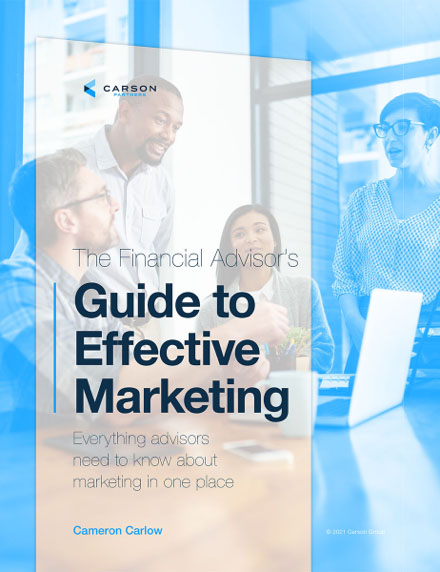It might be shocking to learn that one of the most recognizable names in financial services is still the late Bernie Madoff. So you could say we have a trust problem in our industry.
Even though the 2021 Edelman Trust Barometer found that trust in financial services increased during the height of the COVID-19 pandemic, it has since decreased.
Financial advice is a trust- and relationship-based business. And there are ways you can work to increase trust in the industry while also positioning yourself as a trusted expert: through developing content that gets people to know, like and trust you.
You can’t get people to trust you until they know who you are, and they won’t trust you unless they like you. In this article, we’re going to talk about how to get people to know you, how to get them to like you and then how to create the content to get them to trust you.
Think of people we collectively know, like and trust. For one, there’s Oprah. For 40 years, she’s told us what to read and how to make our lives better spiritually and emotionally. We feel like she’s an old friend because she’s been a dependable presence for us.
Then there’s Dwayne “The Rock” Johnson. Who doesn’t love that guy? He got famous in professional wrestling – not exactly a trustworthy profession – but we adore him because he is authentic. There was a movement to get Johnson to run for president, but we wouldn’t have trusted him anymore because he’d have gotten out of his swim lane.
We’re not promising that following the advice in this article will make you the Oprah of financial services, but it might get you one step closer.
Getting People to Know You
Getting people to know you is about consistency and clarity.
Consistency because it’s the hardest part of marketing, but it’s wildly important. You have to show up consistently – even if you’re tired of hearing yourself talk and you’re tired of writing. You get known by developing a cadence people can depend on. They know they’re going to hear you every Monday on the Framework podcast or read your column every month in Forbes.
Clarity is about having clear positioning. In order for people to know you, you have to know you. Positioning is the metaphorical position that you own in the mind of your target consumer. Walmart has a very clear position – it’s the cheapest. Target is style on a budget. Your positioning is your swim lane. It will help you, like it helped The Rock, decide what parameters you’ll stay in. The Rock decided running for president wasn’t in his parameters.
Read more: Financial Services Is The Least Trusted Industry, And Here’s Why
A positioning statement is the actual articulation of your swim lane. Here is the formula to use:
- What: The only (what service category do you live in)
- How: that (how you are different from everybody else in that category)
- Who: for (your ideal client who you’re uniquely qualified to serve)
- Why: who (why do they need you)
- When: during (the underlying event in their lives that makes you need them)
An example of an established brand’s positioning statement using this exercise is Ikea:
- What: The only home furnishing store
- How: that creates stylish, affordable furniture
- Who: for starving artist Sarah
- Why: who wants a well-designed home
- When: while everything else in life is getting more expensive.
You’re a financial advisor, but your differentiating characteristics, who you want to serve and why they need you now are a few things to work through.
Your positioning statement is the most useful piece of content you’ll ever create, but you will never show it to anyone. This is for you so when you’re looking at creating content, you could evaluate if that content matters and if it’s in line with your swim lane.
Getting People to Like You
Disclaimer: Not everybody is going to like you, and that’s OK. The people who don’t like you are not your people.
It’s important to keep in mind that people like people, not businesses. As such, people like businesses that feel like people. It’s always about the advisor sitting across the table, not the name on the door. And what makes you likable is your personality. What are the things people who love you love about you? Think of the characteristics that define your voice and your personality.
There are people in financial services who have a very distinct voice. For example, Josh Brown is sarcastic, irreverent, witty and pop culture-oriented. Dar’shun Kendrick, RIA owner turned Georgia representative, is uplifting, inspirational and optimistic.
What is your unique voice? There are many adjectives, but it’s best to pick three to five that really define you, then dive deeper into each of those. For example, if you pick humorous, you can dive deeper into that by saying this means you have playful language and great anecdotes, but you’re not crude or silly. Then you can weigh your communication against your definitions and ensure you’re sounding how you want to sound.
How to Get People to Trust You
Trust has been found to be the most important aspect in the client-advisor relationship, according to Investopedia. So maintaining and building that trust is critical to your success. Content – whether it’s written, video or a podcast – shows people what you know and how you can solve their problems. We trust people who can help us solve our problems.
Building trust through content boils down to relevance, consistency (this concept is so important, we mention it twice) and vulnerability.
Relevance. Content that is relevant, both to consumers and to your peers, will help you build trust. When you’re putting together relevant content for prospects, you want to show them how you can solve their problems or help them understand something. This could include anything from content that explains the financial implications of current events to the basics of a Roth conversion and how it might be advantageous for them.
Relevant content for your peers ranges from pieces or videos on professional development or practice management to interviews with industry trailblazers on what they’re doing right – and what they’ve learned from their mistakes – on your podcast.
Read more: 12 Questions Every Advisor Should Ask When Building a Winning Content Marketing Strategy
Consistency. We trust people who show up consistently and when they say they will. If you say you have a podcast episode every Monday, then have a podcast episode every Monday. If your blog posts are set to publish every other Wednesday, ensure you follow that schedule.
Vulnerability. The most impactful content we consume is content that makes us feel like we know the creator. We all know Jamie Hopkins. And reading some of the raw pieces he’s written about losing his dad at a young age makes you feel like you know him better. It makes you trust him because he trusted you, the reader, with such a personal story.
Creating the Content
There are several avenues to generating content, but we’ll only talk about two here: writing and video. One thing to keep in mind here is that people’s attention span is under 10 seconds, so you need to hook them and put the most important information at the beginning.
Writing. If you’re new to writing, it can feel intimidating to sit down and write an article. But let this article serve as your training wheels to get started. Let’s break down the anatomy of this article:
- The lede: This is the element that attempts to hook readers and get them interested. (It might be shocking to learn that one of the most recognizable names in financial services is still the late Bernie Madoff. So you could say we have a trust problem in our industry.)
- The nut graf: This is your article’s mission statement that answers the questions: why am I writing this and why do people care? (Financial advice is a trust- and relationship-based business. And there are ways you can work to increase the trust in the industry while also positioning yourself as a trusted expert: through developing content that gets people to know, like and trust you.)
- The article body: This is the meat of the article, usually split by subheads to organize it and separate the main points. So in this one, we have: Getting People to Know You, Getting People to Like You, Getting People to Trust You, and Creating the Content.
- The tail: This is the last few sentences that wrap up your article (down below, the last three lines are your tail).
You can simply take this skeleton of this article and use it for your own articles in the future.
Video. You should utilize video no matter what for two reasons: first, video encompasses everything we’ve talked about in this article – it shows vulnerability (it’s hard to be on video!), it allows people to connect with you and it also makes you more relatable. Second, it can’t be overlooked anymore – especially after the pandemic. It’s the next best thing to being in the room with somebody.
Everything in our sales funnel is about driving people deeper into a conversation with us. Video does a fantastic job of this because it lets people see and hear you. But from a more practical perspective, every social platform is favoring video more. Social videos get 12 times more shares than posts with just images. Video is the way things are moving.
Video has a similar basic structure you can utilize:
- Preview: Tell the audience what you’re going to tell them.
- Substance: Tell it to the audience.
- Recap: Tell them what you just told them.
- Call to Action: Tell them what to do next.
Some things to keep in mind with video: You don’t have to put on full makeup and script your video. It’s OK if it’s not perfect because people want to see you being who you are – being vulnerable makes you more relatable.
Remember that anything highly polished reeks of fakeness. You want to be authentic and relatable in all that you do, and creating content is no exception.
The key things to take away from this article are this: to get people to know you, you have to define your positioning; to get people to like you, you have to speak your own voice; and to get people to trust you, you have to consistently share your expertise.
This article was derived from an Excell 2021 presentation by the authors. Click here to view the playback. Want more great content like this live? Register for Excell 2022 today.


